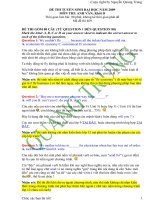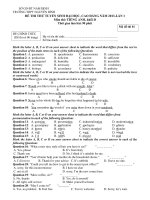BỘ ĐỀ THI THỬ TN MÔN ANH VĂN I pdf
Bạn đang xem bản rút gọn của tài liệu. Xem và tải ngay bản đầy đủ của tài liệu tại đây (111.99 KB, 3 trang )
BỘ ĐỀ THI THỬ TN MÔN ANH VĂN I
I. PHONETICS
Chọn từ mà phần gạch chân có cách phát âm khác với các từ còn lại
1. A. forget B. open C. popular D. font
2. A. easy B. seat C. learn D. eat
3. A. prepare B. engine C. invention D. electricity
Chọn từ có trọng âm chính nhấn vào âm tiết có vị trí khác với các từ còn lại
4. A. product B. satisfy C. mistake D. however
5. A. interesting B. surprising C. amusing D. successful
II. VOCABULARY _ GRAMMAR
Phần này gồm những câu chưa hoàn chỉnh, hãy chọn câu trả lời đúng nhất để điền vào chổ trống
6. Language is not necessarily the private . . . . . . . . . . . of those who use it.
A. job B. work C. career D. property
7. To people in Africa, Asia and South America, English is an important language . . . . . . . . .
A. for mastery B. for mastering C. to master D. necessary to master
8. School- leavers tend to . . . . . . . . . . . any problems they may meet when they start work.
A. get over B. put aside C. play down D. put down
9. It was not easy to find a suitable job. . . . ., I met with a lot unsuccessful job interviewers.
A. in contrast B. on the contrast C. on the opposite D. on the contrary
10. Farmers can protect their land by growing different . . . . . . . . . . .
A. trees B. seasons C. products D. crops
11. Preserving natural . . . . . . . . . . . is of great importance.
A. sources B. resources C. land D. swamps
12. There is a . . . . . . . . . . to choose young people who are qualified for the job.
A. work B. tendency C. means D. direction
13. Exhausts . . . . . . . . . . pollutes the air.
A. smell B. fume C. lauds D. perfume
14. The . . . . . . . . . . of crops on the same land can prevent soil exhaustion.
A. making B. rotation C. planting D. pouching
15. Children are . . . . . . . . . . to overcome problems.
A. suggested B. determined C. insisted D. decided.
16. Would you like . . . . . . . . . . the cinema?
A. to come B. come C. coming D. to have come
17. Do you mind. . . . . . . . . . . . . . . such a long way to work everyday?
A. to travel B. travel C. to have traveled D. travelling
18. Paula has given up . . . . . . . . . . . to lose weight.
A. try B. trying C. to try D. to have tried
19. Neither the students nor their lecturer . . . . . . . . . . English in the classroom
A. uses B. use C. are using D. have used
20. . . . . . . . . . . my friends were unsuccessful at the job interviews.
A. Most B. Mmost of C. Mmost out of D. The most of
21. They know . . . . . . . . . . about what to expect.
A. little B. few C. many D. a lot of
22.My boss seems to be . . . . . . . . . . with my work
A. unsatisfied B. dissatisfied C. imsatisfied D. insatisfied
23. All of us think that she has a . . . . . . . . . . voice.
A. beauty B. beautiful C. beautifully D. beautifullness
24.She enjoys . . . . . . . . . . and she writes five pages everyday.
A. writes B. write C. writing D. to write
25. Each room in this house . . . . . . . . . . its own T.V
A. is having B. are having C. has D. have
III WRITING
Mỗi câu có 4 từ hoặc cụm từ được gạch dưới và đánh dấu A, B, C, D hãy chọn 1 từ hoặc cụm từ có
chứa lỗi
26. He knows how to repair the car without take the whole car apart.
A B C D
27. She can play the piano more good than her sister.
A B C D
28. Please don't make so much noise. I study .
A B C D
29. Jane looks beautifully in her new dress.
A B C D
30. I don't know how many people there is for lunch.
A B C D
Hoàn thành câu bằng 1 cụm từ hoặc 1 mệnh đề
31. We can reclaim land by irrigating deserts, draining swamps and . . . . . . . . . . . . . . . . . . . .
A. to push back the sea B. and then push back the sea
C. we then push D. pushing back the sea
32. Once used up, . . . . . . . . . . . . . . . . . . . . . . . . . . . . . .
A. these minerals can never be replaced B. we can never replaced these minerals
C. but these minerals can never be replaced D. can these mineral be never replaced
33. He wanted to win the race. He ran . . . . . . . . . . . . . . . . . . . . . . . . . . . . . .
A. faster than he can B. faster as he could
C. as fast as he could D.so fast as he can
34. Please tell me where . . . . . . . . . . . . . . . . . . . . . . . . . . . . . .
A. does Peter live ? B. Peter lives C. Peter had lived D. is Peter living
35. Lan has learned English . . . . . . . . . . . . . . . . . . . . . . . . . . . . . .
A. since she was a small girl B. since she would be a small girl
C. since she has been a small girl D. since she had been a small girl
IV. READING
Hãy chọn từ thích hợp (A, B, C,hoặc D) để điền vào chổ trống trong đoạn văn sau
Water is . . . . (36). . . . . for life. People can live only a few days . . . . (37) . . it. Yet nearly 25
million people die each year because of it. Both industrial nations and developing countries are worried
about the . . . . . (38) . . . . and quantity of water in the world.
Even though people, animals, agriculture, and industry use a lot of water, there is more than
enough on the earth. Water covers about . . . . (39) . . . . . . of the Earth's surface. However, 97.4 percent
of it is salt water. Three-fourths of the Earth's fresh water is frozen in glaciers and in the great polar ice
caps. Most of the water we use . . . . (40). . . . . . from rivers, lakes, and the atmosphere. Less than one
percent of the Earth's water is . . . . . (41) . . . . ., and we use it over and over again.
One of the . . . (42) . . . about water is distribution. Water is not always . . . .(43) . . . . . where
the large. . . . (44). . . . centers are. Some. . . . .(45). . . . get enough rain. But it is all in one or two short
rainy reasons.
36. A. important B. useful C. necessary D. helpful
37. A. with B. without C. for D. in
38. A. characteristics B. conditions C. situation D. quality
39. A. three-four B. three-fourth C. three-fours D. three-fourths
40. A.arrives B. comes C. goes D. gets
41. A. useful B. used C. usable D. using
42. A. cases B. things C. facts D. problems
43. A. distributed B. sent C. supplied D. transported
44. A. people B. population C. men D. women
45. A. zones B. places C. regions D. villages
Đọc đoạn văn và chọn câu trả lời đúng (A, B, C hoặc D)
The research of alternative resources of energy has resulted in various directions. Many
commuinties are burning garbage and other biological waste products to produce electricity. Changing
waste products into gases or oil is also an efficient way to dispose of waste.
Experimental work is being done to make synthetic fuels from coal, or coal tars. But today, that
process has proved expensive. Other experiments are underway to harness power with giant windmills.
Geothermal power, heat from the earth, is also being tested
Some experts are trying to revive hydroelectric power which is derived from stream and rivers.
Fifty years ago, hydroelectric power provided one-third of the electricity used in the United States, but
today it supplies only four per cent. The oceans are another source of energy. Scientists are studying
ways to change the energy of ocean currents, tides, and waste into electricity. Experiments are also
underway to make use of temperture differences in ocean water to produce energy
46. What are many communities doing to produce electricity?
A. Burning garbage and other boilogical waste
B. Changing waste products into gases or oil
C. Doing experimental woek
C. Making synthetic fuels
47. Has the process of making synthetic fuils from coal. Or coal tars proved expensive?
A. It depends B. It has not been proved
C. Yes, it has D. No, it hasn't
48. What percentage of the electricity used in the United States hydroelectric power provide today?
A. 1/3 B. 50% C. 4% D. 40%
49. What are another source of energy?
A. geothermal power B. biological wastes C. coal tars D. the oceans
50. What is the possible title for this passage?
A. alternative resources of energy B. another source of energy
C. the reseach of new energy D. exeriments to produce energy
THE END









